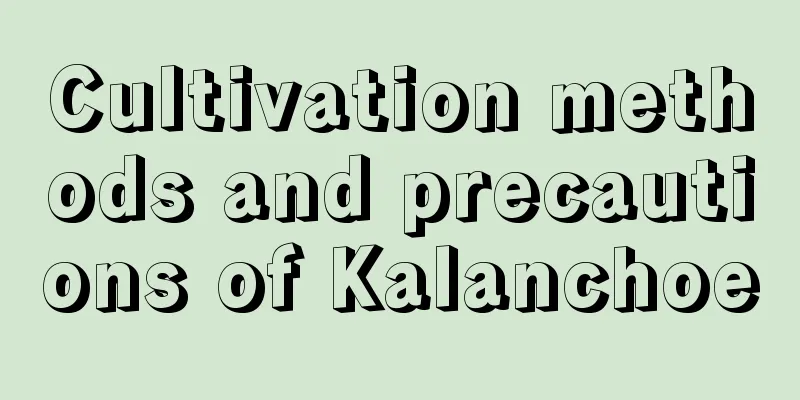Cultivation methods and precautions of Kalanchoe

|
Kalanchoe has become a favorite for interior decoration with its colorful flowers and emerald green leaves. However, many flower lovers will encounter problems with flowers being difficult to bloom or easily withering during the maintenance process. In fact, as long as you learn the correct maintenance methods, you can make the Kalanchoe bloom all year round and be beautiful. Let’s learn about the cultivation methods and precautions of Kalanchoe below. 1. Don’t overwater Kalanchoe requires moderate moisture, but overwatering can cause root rot. Watering once a week is usually sufficient. Check soil moisture before watering and only water when the soil surface is dry. When watering, moisten the soil evenly to avoid concentrating water at the roots. 2. Do not expose to direct sunlight Kalanchoe prefers bright light, but strong direct light will damage the leaves. The Kalanchoe should be placed in a place with soft light and plenty of diffuse light, such as near a window but away from direct sunlight. Turn the plants regularly to ensure even light exposure and prevent the leaves from being damaged by strong light from one direction. 3. Don’t over-fertilize Appropriate fertilization is beneficial to the growth of Kalanchoe , but excessive fertilization will cause the plant to grow too fast and affect flowering. Generally, fertilize once a month. After fertilizing, rinse the flower pots and leaves with clean water to prevent fertilizer damage. 4. Don’t ignore temperature and humidity Kalanchoe has certain requirements for temperature and humidity, and extreme temperatures will affect its growth. The suitable growth temperature is 15°C to 25°C. Too high or too low temperature is not conducive to Kalanchoe. At the same time, Kalanchoe is sensitive to humidity, and moderate humidity indoors is essential for its growth. To adjust the temperature and humidity, the following measures can be taken: Temperature control: When the temperature is high in summer, place the Kalanchoe in a ventilated place and avoid direct sunlight. The indoor temperature can be adjusted by air conditioning or electric fans. When it is cold in winter, move it to a warm place to avoid cold damage. Humidity control: Kalanchoe requires higher humidity, especially in the dry winter or when using heating. You can increase the indoor humidity by using a humidifier, placing a water tray or spraying water mist. 5. Notes Regular pruning: Cut off old and yellow leaves in time to promote new growth and keep the plant beautiful. Change the soil in time: Change the soil every spring or autumn to ensure nutrients and drainage. Pest control: Check the plants regularly and treat any pests with pesticides or natural methods. In short, when caring for Kalanchoe, you should pay attention to temperature and humidity regulation, and prune, change the soil and prevent pests in a timely manner. By taking all these factors into consideration, the Kalanchoe can grow healthily and continue to bloom beautiful flowers.
|
<<: Clivia cultivation methods and precautions
>>: Camellia cultivation methods and precautions
Recommend
When is the best time to transplant lettuce?
Lettuce, which is what we call leaf lettuce, is m...
When is the best time to sow mosquito repellent grass?
Suitable time for sowing mosquito repellent grass...
Cultivation methods and precautions of European hydrangea
European hydrangea is a shrub of the Caprifoliace...
Putting this flower in the living room can "ward off evil" and "bring good luck", and the key is that it is easy to grow
Some people think this is a good thing. In today&...
Is the miniature coconut palm a shade or sun-loving plant?
Do miniature coconut palms prefer shade or sun? T...
Cultivation methods and precautions of Chinese boxing ginseng
1. Lighting The boxwood prefers a cool growing en...
Can the vine be potted?
Can this plant be potted? The answer is: Yes. How...
How to use aspirin to grow lucky bamboo
1. Usage 1. Prepare half a tablet, put it in a sm...
How to grow orchids in winter
1. Temperature The temperature is relatively low ...
Can bitter melon be planted all year round? When is the best time to plant it?
Bitter melon originally grew in South Asia and In...
How to grow Begonia sempervivum
temperature Begonia is not cold-resistant, so the...
Bream breeding methods and techniques
Bream grows quickly, has strong adaptability and ...
How to cultivate Anthurium
Anthurium growth conditions Anthurium needs suffi...
How to eat monk fruit and what to pair with it in soup
1. How to consume The simplest way to eat monk fr...
What is the reason why the palace lantern longevity flower does not grow flower buds? (The palace lantern longevity flower grows too long but does not grow flower buds)
The Kalanchoe family is large, with hundreds of f...









